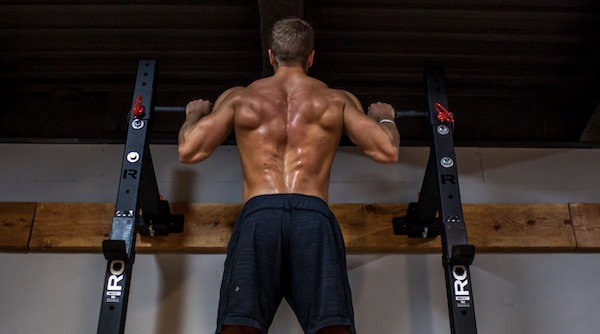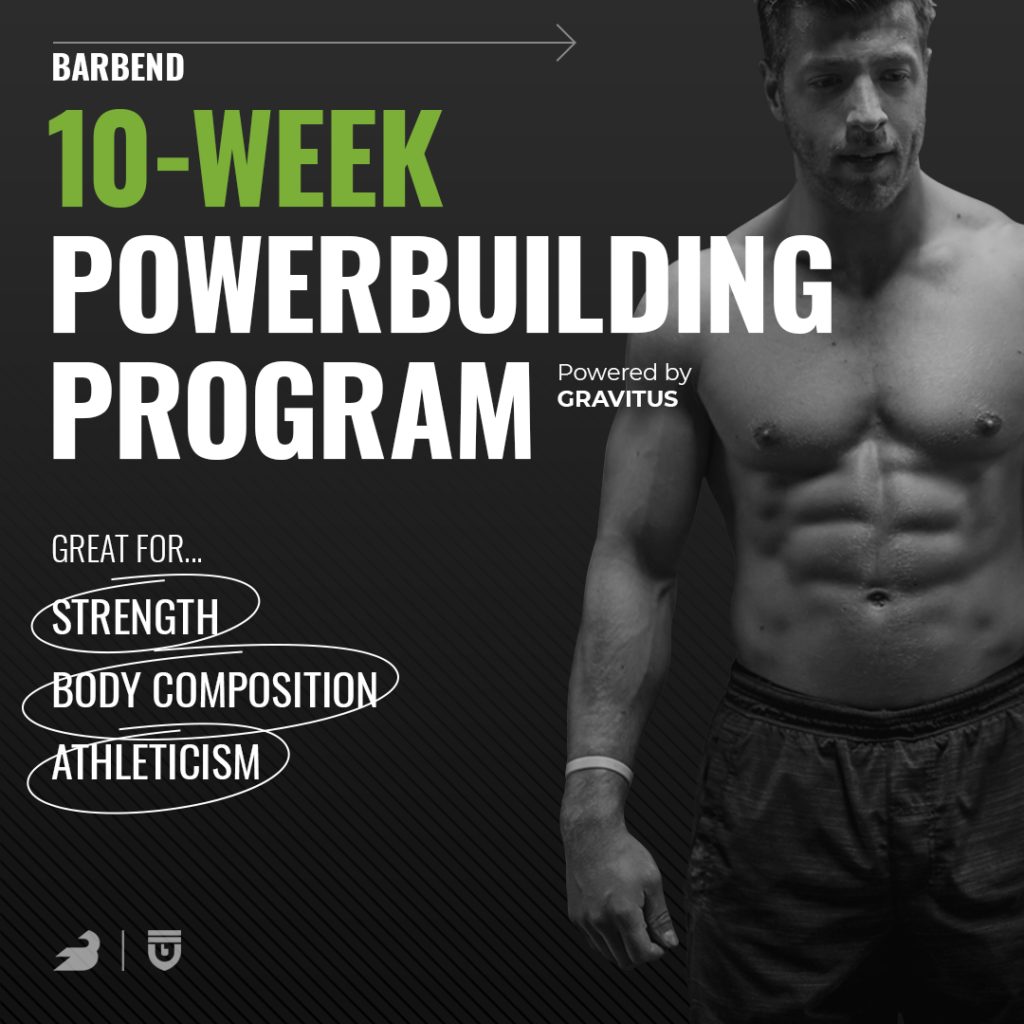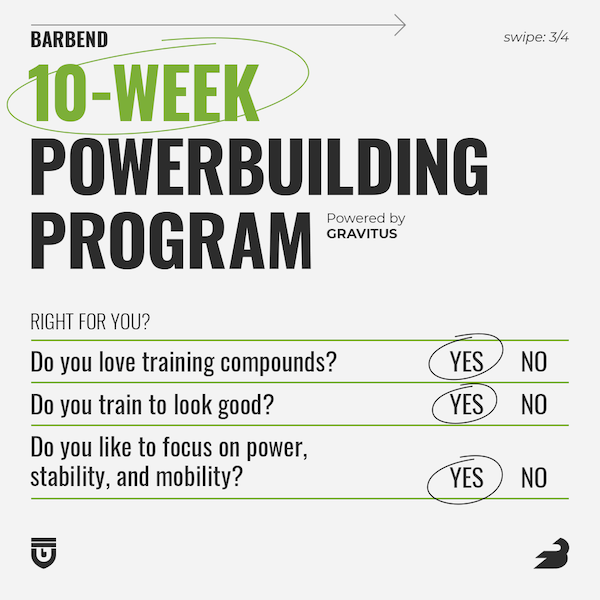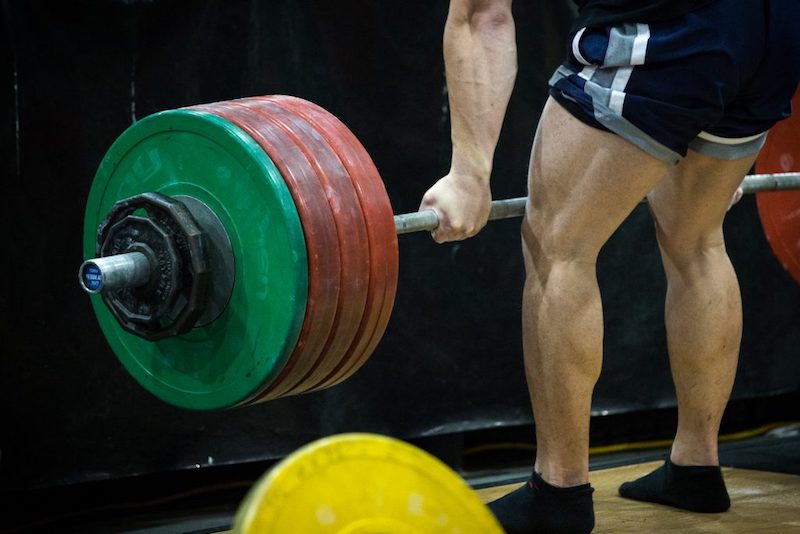Powerbuilding, a relatively new and trendy buzzword in strength training, is continuing to grow in popularity due to the principles that most powerbuilding programs aim to accomplish: (1) get stronger, with periodized compound movements and (2) look better, with specific and curated accessories.
Powerbuilding programs blend foundational concepts taken from powerlifting and bodybuilding styles of training. This means athletes simultaneously improve their strength through the use of the squat, bench press, deadlift, and overhead press, while also focusing on their body composition with accessories catered to the aesthetics of specific areas on the body.
At BarBend, we’ve had the chance to learn programming techniques from elite athletes and coaches across all strength training disciplines, and we wanted to distill our learnings into a powerbuilding guide for you. Furthermore, we wanted to build the ultimate powerbuilding program and that’s why we teamed up with Gravitus to launch our new 10-week training program in their mobile app.

The BarBend 10-week powerbuilding program is the perfect option for lifters who want to improve their strength, body composition, and overall fitness.
- What is powerbuilding?
- Benefits of powerbuilding programs
- Powerbuilding program principles
- Powerbuilding program FAQs
- BarBend 10-Week Powerbuilding Program
What Is Powerbuilding?
Powerbuilding is the combination of powerlifting and bodybuilding styles in one training program. A powerbuilding program will include both high intensity, low rep work for strength, which is used in powerlifting programs, along with low intensity, high rep work for body composition, which is similar to traditional bodybuilding training.
The concept of powerbuilding is by no means new, as this style of training has been popular for quite some time across every strength circle. However, powerbuilding style programs are continuing to grow in popularity for two big reasons.
The first reason is that a vast portion of the lifting community wants to tackle multiple goals at once and doesn’t necessarily want to subscribe to only one style of training. This makes powerbuilding programs desirable because they aim to accomplish multiple goals at once such as strength, body composition/fat loss, and power.
The second reason powerbuilding programs are continuing to grow in popularity is the fact that coaches and periodization continue to evolve. More than ever, coaches are starting to truly invest more thought into building intuitive programs, and since powerbuilding programs are continuing to grow in popularity, coaches are now spending more time sinking resources into them.
What Are the Benefits of Powerbuilding?
The benefits of powerbuilding will be individual, however, there are a few main benefits that come along with running this style of training program.
It’s important to remember that powerbuilding programs, based on their timeline and training goals, will all vary slightly when it comes to their benefits. However, the four benefits below will generally reign true for every powerbuilding program, and these benefits will shift in a hierarchy fashion depending on a coach’s/program’s principles and methodologies.
1. Strengthen Compound Movements
One of the biggest benefits of a well-written powerbuilding program is the use of periodized progression for the main compound movements to give athletes the ability to make progress on their favorite movements, the squat, bench press, deadlift, and overhead press, while simultaneously juggling other goals.

2. Curated Accessories
Powerbuilding programs include accessories designed to support the compound movements but also geared towards building up specific body parts. This makes these programs a great option for lifters trying to improve their overall body composition.
3. Multi-Goal Focus
If you like to program hop, or have multiple goals that you want to tackle at once, then a powerbuilding program can be a good bet for keeping you on track. As opposed to diving into the rabbit holes of strength or hypertrophy alone, and potentially creating boredom, powerbuilding programs keep the training dynamic by blending multiple training goals into one progression.
4. Create a Foundation
Recreational lifters and casual strength athletes can build a great foundation with powerbuilding programs. Some single-discipline programs can be limited in nature when it comes to building dynamic strength across multiple areas, or general physical preparedness, due to limited exercise selection, among other things.
Good powerbuilding programs provide periodized compound movements to build a foundation of strength, along with accessories to support them and to build upon lagging areas that can sometimes not receive enough attention with only performing compound lifts.

Powerbuilding Program Principles
Every great strength training program is built on a foundation of solid principles. These principles serve as the pillars or guidelines for decisions on the flow or schedule of the workout program, and these principles dictate what’s included in your workouts in order to reach your desired training adaptations.
In this article, we’ll dive into three resistance training principles that are prevalent in powerbuilding programs, along with examples of how they’re used in these programs.
1. Principle of Specificity
The principle of specificity entails the exercises and training variables chosen in a program to accommodate for a specific activity or goal-oriented task. In a powerbuilding program, specificity will vary based on the program’s overarching goals.

Powerbuilding Example: If you’re following a powerbuilding program that has a greater focus on strengthening the compound movements, then you’ll generally have higher intensities and volumes for the big lifts and more accessories that are variations of them. Variables like intensity, volume, rest times, and training frequency will all reflect the specific goal at hand.
- Training Goal: Strengthen Compounds
- Leg Day Example
| Exercise and Rest Times | Sets, Reps, and Intensity |
| A1. Back Squat | 4 x 4 @ 1-2 RIR |
| B1. Leg Press | 3 x 8 @ 2 RIR |
| C1. Bulgarian Split Squat | 3 x 6 ea leg |
2. Principle of Overload
The principle of overload entails the strategic, scalable, and laid out plan for increasing a stress on a specific adaptation. In a powerbuilding program, overload can manifest in multiple ways and this will be related to the program’s main goals.
Powerbuilding Example: If you’re following a powerbuilding program that is focused on body composition and work economy, then you’ll generally see higher rep compounds with lower and moderate intensities, and accessories that have tempos and rest times manipulated for the two training goals.
- Training Goal: Improve Bench Press Strength
- Upper Body Example
| Exercise and Rest Times | Sets, Reps, and Intensity |
| Week 1: A1. Barbell Bench Press | 4 x 7 @ 2 RIR |
| Week 2: A1. Barbell Bench Press | 4 x 7 @ 1-2 RIR |
| Week 3: A1. Barbell Bench Press | 4 x 6 @ 1-2 RIR |
3. Principle of Variation
The principle of variation describes the idea of using different degrees of change within a program to create continual progress. This entails using movement variations, accessories, and other training variations to progress a goal-specific task.
Powerbuilding Example: Let’s say you have a goal of progressing the deadlift specifically within a powerbuilding training block. The principle of variation would then entail alterations in things like tempo, accessories, sets, reps, and intensities.
- Training Goal: Improve Deadlift
- Deadlift Training Example
| Exercise and Rest Times | Sets, Reps, and Intensity |
| A1. Conventional Deadlift | 5 x 3 @ 1-2 RIR |
| B1. Deficit Deadlift | 3 x 5 @ 2 RIR |
| B2. KB Paused Deadlift | 2 x 8 / Tempo 3111 |
Powerbuilding Program FAQs
What are the goals of powerbuilding programs?
The primary goals of powerbuilding programs are to improve strength, body composition, and all around fitness. This makes powerbuilding programs great options for lifters who are trying to build a foundation of strength, decrease body fat (when paired with a strategically planned diet), and improve overall fitness levels by upping total work capacity.
What's the difference between powerlifting vs. bodybuilding programs?
Outside of exercise selection, powerlifting and bodybuilding programs will be different in two fundamental ways and these include how much the body is loaded and the total working volume of the program.
- Powerlifting programs will make their focal point loading the competition movements, and use accessories that are variations of the squat, bench press, and deadlift, rooted in the principle of specificity.
- Bodybuilding programs make their primary focus increasing time under tension for various muscle groups, and manipulate their training volume and frequency on noticeable lagging areas.
What is the difference between strength and hypertrophy?
Strength is defined as the capacity of an object to withstand an external force and the quality of being physically strong. Hypertrophy means the enlargement of an organ or tissue.
In powerbuilding programs, strength and hypertrophy are the byproducts of intensities, volumes for certain exercises, along with other programmed training variables.
Can powerbuilding programs get me strong and big?
Strength and size are dictated by multiple variables. A powerbuilding program can do wonders for improving strength and overall musculature, but a program itself will not be the only determinant of these two characteristics. Recovery, diet, sleep, and other life factors should be taken into consideration and dialed in accordingly with the use of a well-written powerbuilding program to get strong and big.
Can I lose weight on a powerbuilding program?
Absolutely, but the program itself will not warrant weight loss. While a powerbuilding program can help build muscle and burn calories, diet, sleep, and other variables will be far more important in predicting and dictating overall weight loss.
What exercises are in powerbuilding programs?
There are handfuls of different exercises that can be included in powerbuilding programs, and these will reciprocate the coach’s methodology who wrote the program and the training adaptations trying to be established.
Generally, powerbuilding workouts will have a compound movement as the main focus for the day, then the accessories that follow are usually variations of the compound movement and more specific in nature on body parts with a bodybuilding focus. Some example exercises that you can see in powerbuilding programs include:
- Compound Exercises: Squat, bench press, deadlift, overhead press, barbell row, block pull, trap bar deadlift
- Accessories Exercises: Lunges, dips, pull-ups, dumbbell rows, landmine presses, curls, planks
Exercises in powerbuilding programs vary greatly, and it really depends on who’s writing the program. Some coaches structure programs with a high degree of specificity, while others integrate more variety.
Can beginners use powerbuilding programs?
Yes! However, beginners should always be mindful of not putting the cart before the horse. Essentially, powerbuilding programs have multiple accessories that may not have as much benefit for beginners who lack a foundation of strength to begin with. That being said, beginners can follow powerbuilding programs, but they should aim to build their foundation and be proficient in the compounds first.
BarBend 10-Week Powerbuilding Program
At BarBend, we’re huge fans of powerbuilding programs. We think they’re great for helping recreational lifters get a taste of both strength and body composition focused training. In addition, they can be great programs for helping lifters establish where they might have higher levels of interest, and help them even get more involved in niche strength sports. Consider powerbuilding a gateway drug to powerlifting and bodybuilding.
This love for powerbuilding is what led me to build a 10-week program for Gravitus. Over the last seven years, I’ve coached multiple athletes within the niche of powerbuilding style programs, and this program has got to be one of my favorites to date. Below, I’ve included some of the most notable details about the program.

The BarBend 10-week powerbuilding program is the perfect option for lifters who want to improve their strength, body composition, and overall fitness.
Program Goals
This 10-week program breaks each movement into hypertrophy and strength training blocks, then deloads them, and ramps them up respectively.
- Program Primary Goals: Strengthen 1-rep maxes in the compound movements and increase lean body mass.
- Program Secondary Goals: Improve lagging areas that typically accompany heavy-compound only focused training, focus on athleticism with plyometric and transverse movement plane exercises, and build a stronger core.

Exercise Flow
There are four days in the program and each of them focus on one compound movement including the squat, bench press, deadlift, and overhead press. The accessories that follow the compounds are designed to strengthen that movement and general lagging areas that can be missed when following very specific training styles.
There’s also an optional supplemental fifth day for general conditioning and for lifters who want to train five days a week and have the energy to do so.
Auto-Regulation
This program is designed to adapt to you as you progress through it. Instead of traditional programs where you need to know your 1-rep max at the start of the program, and where goals for each day are calculated as percentages of this max, this program uses the concept of reps-in-reserve to specify intensities. In this way, no matter how strong you’re feeling on a particular day, the targets ensure that you’re making the most of the energy and strength you have, in order to end the 10 weeks with maximal gains from the training.
Blocks and Deloads
As mentioned above, this program has two training blocks: strength and hypertrophy. Each movement will have its respective day’s flow modified to best suit the training adaptation being sought out.
Instead of using traditional deloads for full weeks of training, this program deloads individual movements and training days with similar movement patterns. For example, the upper body movements deload every fourth week, while the squat deloads every fifth week, and deadlift every sixth week.
This allows for continual progress in at least one area of the program, and to re-calibrate energy for specific movement patterns before shifting into new training blocks.

The Gravitus App
Gravitus and BarBend have worked hard to make sure every aspect of the program is built right into the Gravitus mobile app. We wanted to ensure that lifters could get started right away with the program, without having to first understand written descriptions of the progression, or to parse a spreadsheet before reaping the benefits. And Gravitus is unique among training apps in that their no-fuss interface is focused on real lifters, of any level, like yourself.
Videos and tips are accessible, but not front and center. Concepts like RPE or tempo training are presented in the way lifters would expect, with tooltips to assist those new to the concepts. And at the end of the day, all your training data from the program or from workouts you log on your own is tracked in one place for you to analyze. And your workouts can optionally be posted to the Gravitus community and to any friends who might be running the program with you.
At its core, Gravitus helps you make sure you’re running the program the way it was designed, and performing the movements the way we’d have you perform them, as if we were coaching you 1-on-1. Adherence is the name of the game to get the most out of what we’ve crafted for you, and by making that easy, all you have to do is lift and enjoy the training.
Wrapping Up
Powerbuilding programs continue to grow in popularity and for good reason. They’re awesome programs for recreational athletes and lifters that love training for multiple goals during one training block, and want to progress in a methodical manner.
Gravitus is an app that helps athletes everywhere track their progress with ease with their highly-detailed and intuitive interface. To learn more about the BarBend program, make sure to check out our program on the Gravitus app.

The BarBend 10-week powerbuilding program is the perfect option for lifters who want to improve their strength, body composition, and overall fitness.
